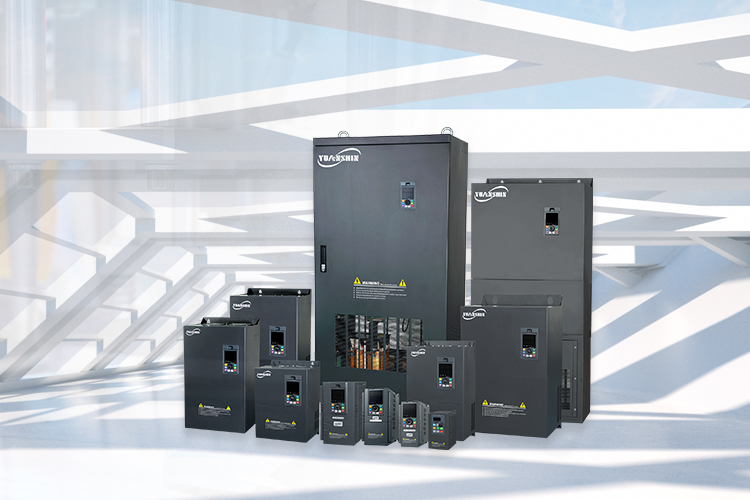Low voltage inverter
How to choose the capacity of the frequency inverter?
The allowable current of the inverter has an inverse time relationship with the process time. For example, 1.2 (1.5)times the rated current can last for 1 minute, and 1.8 (2.0) times the rated current can last for 0.5 minutes. This means that the duration of the allowable overload current provided to the motor at any time must be within a limited
range. For the motor, the index of overload capacity is meaningful only during the start (acceleration) process. During operation, it is actually equivalent to not allowing overload.
The selection of the inverter capacity is an important and complicated issue. It is necessary to consider the matching of the inverter capacity and the motor capacity. A small capacity will affect the effective torque output of the motor, affect the normal operation of the system, and even damage the device. If the capacity is too large, the harmonic
component of the current will increase, which also increases the equipment investment.
Three steps of inverter capacity selection:
1. Understand the nature of the load and the law of change, calculate the size of the load current or make a load current diagram I=f(t)
2. Pre-select inverter capacity
3. Check the pre-selected inverter, and check the overload capacity and starting capacity if necessary.
If all pass, the pre-selected inverter capacity is selected, otherwise, start from the second step until it passes.
To meet the requirements of production machinery, the smaller the capacity of the selected inverter, the more economical Selection basis for inverter capacity:
1. Select the inverter capacity according to the motor current
The inverter is used to drive the asynchronous motor for speed regulation. After the asynchronous motor is determined, the inverter should usually be selected according to the rated current of the asynchronous motor, or according to the current value (maximum value) of the asynchronous motor in actual operation.
2. Select the inverter according to the output voltage
The output voltage of the inverter can be selected according to the rated voltage of the motor. According to my country's standards, it can be divided into 220V and 400V. For a 3KV high-voltage motor, a 400V inverter can be used. An input transformer can be installed at the input of the inverter. Install an output transformer, reduce 3KV to 400V, and then increase the output of the inverter to 3KV.
3. Select the inverter according to the output frequency
The maximum output frequency of the inverter varies greatly depending on the model, 50/60HZ, 120HZ, 240Hz, or higher. The 50/60HZ frequency inverter aims at speed regulation operation below the rated speed, and large-capacity general frequency inverters basically fall into this category.
The inverters with the highest output frequency exceeding the power frequency are mostly small-capacity inverters. In the area above 50/60Hz, the output voltage is unchanged and is a constant power characteristic. Attention should be paid to the torque reduction in the high-speed area.
However, lathes and other machine tools change the speed according to the diameter and material of the workpiece, and use them within the range of constant power. Using high speed at light load can improve productivity, but care should be taken not to exceed the maximum allowable speed of the motor and load.
-
V9 SERIES ECONOMIC VECTOR CONTROL FREQUENCY INVERTER
V9 series products are the main products of Yuanxin electric high performance vector inverter. Adhering to Yuanxin Electric's consistent pursuit of high quality and high reliability of products, it organically combines customers' general needs with customers' personalized needs and industrial needs.
Automatic energy-saving operation: according to the load, automatically optimize the V / F curve to achieve energy-saving operation;Communication function: it has RS485 standard communication interface and supports two Modbus communication protocols of ascil and RTU;Control mode: space voltage vector SVPWM modulation is optimized;In the circuit and process, a variety of protection technologies and new devices are used to significantly improve the anti-interference ability of the whole machine;In the design, the unique tree radiator, switching power supply and other technologies are used to make the performance of the machine more superior;It can realize the frequency swing function with adjustable prefabrication frequency and center frequency;Sensorless vector control (with optimal low frequency dead time compensation characteristics);Super overload capacity: 150% rated current for 1 minute, 180% rated current for 3 seconds;Switch input channel: forward and reverse command; 8-way programmable switch input, 35 functions can be set respectively;Through the built-in PLC or control terminal to achieve multi speed operation; -
YX3000 SERIES GENERAL PURPOSE FREQUENCY INVERTER
Yx3000 series products are the main products of Yuanxin electric high performance vector inverter. Adhering to Yuanxin Electric's consistent pursuit of high quality and high reliability of products, it organically combines customers' general needs with customers' personalized needs and industrial needs.
Automatic energy-saving operation: according to the load, automatically optimize the V / F curve to achieve energy-saving operation;Communication function: it has RS485 standard communication interface and supports two Modbus communication protocols of ascil and RTU;Control mode: space voltage vector SVPWM modulation is optimized;In the circuit and process, a variety of protection technologies and new devices are used to significantly improve the anti-interference ability of the whole machine;In the design, the unique tree radiator, switching power supply and other technologies are used to make the performance of the machine more superior;It can realize the frequency swing function with adjustable prefabrication frequency and center frequency;Sensorless vector control (with optimal low frequency dead time compensation characteristics);Super overload capacity: 150% rated current for 1 minute, 180% rated current for 3 seconds;Switch input channel: forward and reverse command; 8-way programmable switch input, 35 functions can be set respectively;Through the built-in PLC or control terminal to achieve multi speed operation; -
YX9000 SERIES HIGH PERFORMANCE VECTOR CONTROL FREQUENCY CONVERTER
Yx9000 series products are the main products of Yuanxin electric high performance vector inverter. Adhering to Yuanxin Electric's consistent pursuit of high quality and high reliability of products, it organically combines customers' general needs with customers' personalized needs and industrial needs.
Automatic energy-saving operation: according to the load, automatically optimize the V / F curve to achieve energy-saving operation;Communication function: it has RS485 standard communication interface and supports two Modbus communication protocols of ascil and RTU;Control mode: space voltage vector SVPWM modulation is optimized;In the circuit and process, a variety of protection technologies and new devices are used to significantly improve the anti-interference ability of the whole machine;In the design, the unique tree radiator, switching power supply and other technologies are used to make the performance of the machine more superior;It can realize the frequency swing function with adjustable prefabrication frequency and center frequency;Sensorless vector control (with optimal low frequency dead time compensation characteristics);Super overload capacity: 150% rated current for 1 minute, 180% rated current for 3 seconds;Switch input channel: forward and reverse command; 8-way programmable switch input, 35 functions can be set respectively;Through the built-in PLC or control terminal to achieve multi speed operation; -
YX2000 SERIES ECONOMIC SENSORLESS VECTOR FREQUENCY INVERTER
Yx2000 series products are the main products of Yuanxin electric high performance vector inverter. Adhering to Yuanxin Electric's consistent pursuit of high quality and high reliability of products, it organically combines customers' general needs with customers' personalized needs and industrial needs.
Automatic energy-saving operation: according to the load, automatically optimize the V / F curve to achieve energy-saving operation;Communication function: it has RS485 standard communication interface and supports two Modbus communication protocols of ascil and RTU;Control mode: space voltage vector SVPWM modulation is optimized;In the circuit and process, a variety of protection technologies and new devices are used to significantly improve the anti-interference ability of the whole machine;In the design, the unique tree radiator, switching power supply and other technologies are used to make the performance of the machine more superior;It can realize the frequency swing function with adjustable prefabrication frequency and center frequency;Sensorless vector control (with optimal low frequency dead time compensation characteristics);Super overload capacity: 150% rated current for 1 minute, 180% rated current for 3 seconds;Switch input channel: forward and reverse command; 8-way programmable switch input, 35 functions can be set respectively;Through the built-in PLC or control terminal to achieve multi speed operation; -
YX2100 SERIES EMBEDDED FREQUENCY CONVERTER
Yx2100 series products are the Embedded frequency inverter which has compact size and cheap price. , it organically combines customers' general needs with customers' personalized needs and industrial needs.
Automatic energy-saving operation: according to the load, automatically optimize the V / F curve to achieve energy-saving operation;Communication function: it has RS485 standard communication interface and supports two Modbus communication protocols of ascil and RTU;Control mode: space voltage vector SVPWM modulation is optimized;In the circuit and process, a variety of protection technologies and new devices are used to significantly improve the anti-interference ability of the whole machine;In the design, the unique tree radiator, switching power supply and other technologies are used to make the performance of the machine more superior;It can realize the frequency swing function with adjustable prefabrication frequency and center frequency;Sensorless vector control (with optimal low frequency dead time compensation characteristics);Super overload capacity: 150% rated current for 1 minute, 180% rated current for 3 seconds;Switch input channel: forward and reverse command; 8-way programmable switch input, 35 functions can be set respectively;Through the built-in PLC or control terminal to achieve multi speed operation; -
YX3300 SERIES SINGLE BOARD FREQUENCY INVERTER
Yx3300 series products are the main products of Yuanxin electric high performance vector inverter. Adhering to Yuanxin Electric's consistent pursuit of high quality and high reliability of products, it organically combines customers' general needs with customers' personalized needs and industrial needs.
Automatic energy-saving operation: according to the load, automatically optimize the V / F curve to achieve energy-saving operation;Communication function: it has RS485 standard communication interface and supports two Modbus communication protocols of ascil and RTU;Control mode: space voltage vector SVPWM modulation is optimized;In the circuit and process, a variety of protection technologies and new devices are used to significantly improve the anti-interference ability of the whole machine;In the design, the unique tree radiator, switching power supply and other technologies are used to make the performance of the machine more superior;It can realize the frequency swing function with adjustable prefabrication frequency and center frequency;Sensorless vector control (with optimal low frequency dead time compensation characteristics);Super overload capacity: 150% rated current for 1 minute, 180% rated current for 3 seconds;Switch input channel: forward and reverse command; 8-way programmable switch input, 35 functions can be set respectively;Through the built-in PLC or control terminal to achieve multi speed operation;






























